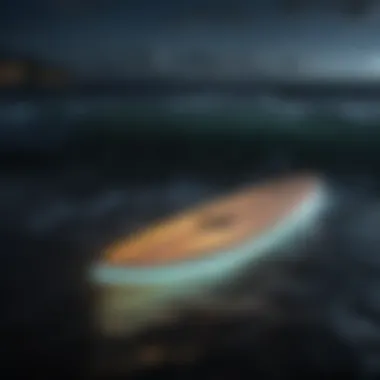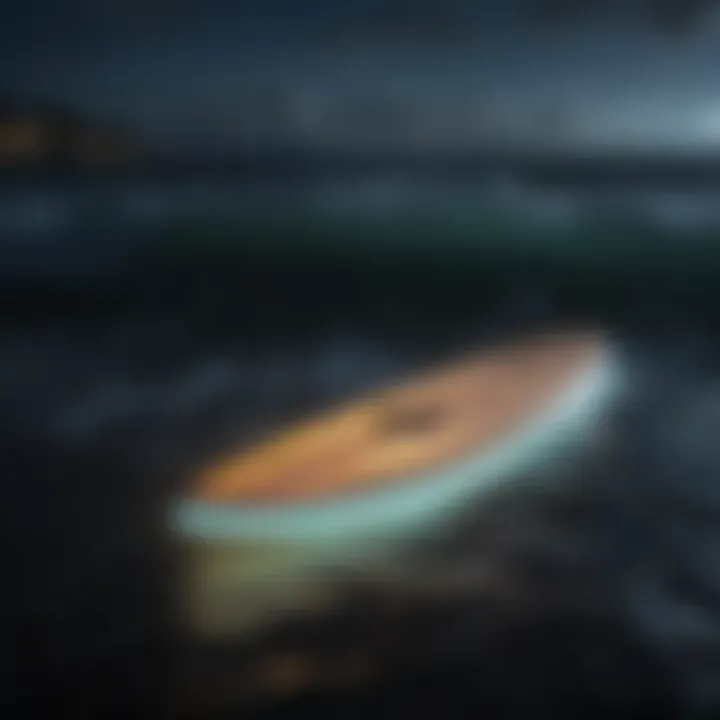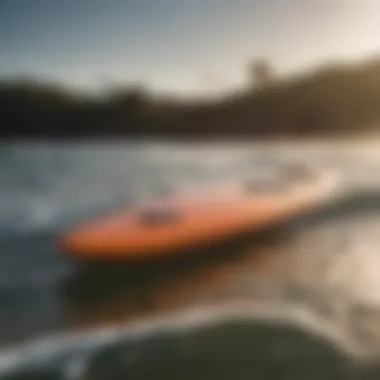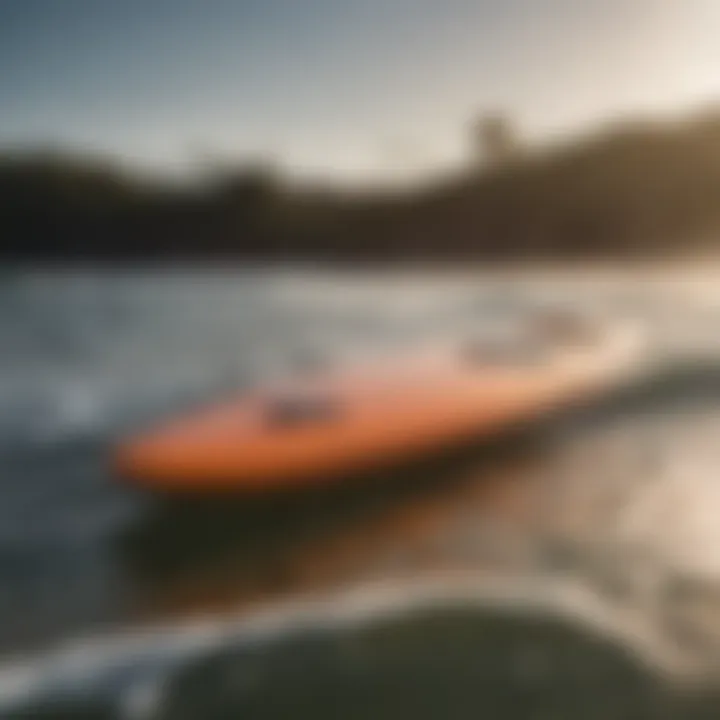The Evolution and Impact of LED Surfboards in Watersports


Intro
The landscape of watersports has witnessed a seismic shift in recent years, especially with the advent of LED surfboards. Gone are the days when surfboards were mere slabs of foam and fiberglass. Today, innovation breathes new life into the surfing experience, and LED technology stands at the forefront of this transformation. These boards not only serve the practical purpose of gliding on waves but do so with an aesthetic flair that turns heads.
Light-emitting diodes, commonly known as LEDs, have found their way into surfboards, making the act of riding waves not just a sport, but an experience that dances with colors. No longer confined to daylight hours or well-lit conditions, surfers can now carve through the waves at night, their movements illuminated by vibrant lights. It’s a development that raises questions about visibility, safety, and the sheer joy of night surfing. Imagine catching a wave beneath a moonlit sky, the glow of your board tracing your path through the water.
The essence of these LED surfboards is not just their eye-catching design; it's also about enhancing safety. As more enthusiasts take to the water at night, visibility becomes key. LED surfboards significantly reduce the risk of collisions and accidents. Besides, for those who thrive on creativity and self-expression, these boards open up a canvas for light-based artistry that has never been seen before in the surfing community. However, the journey of LED surfboards is not without its challenges. Their development involves a unique set of materials and technologies, raising questions about sustainability and environmental impact as well.
In the chapters ahead, we will delve deeper into the intricate workings of LED surfboards, from their component materials to their implications for both safety and creativity. We’ll explore the nuances of user experiences, the prospects for their future, and what role they play in transforming the watersport culture. Through this exploration, we can appreciate how seemingly simple innovations can ripple out, reshaping our interactions with nature and our chosen activities.
The Rise of LED Technology in Surfing
The advent of LED technology in surfing marks a revolutionary leap that many enthusiasts didn't see coming. Traditionally, surfers relied on the natural conditions—like sunlight and moonlight—to guide their adventures on the waves. However, the integration of LEDs into surfboards has changed the game, opening up a whole new world of possibilities. This section explores key aspects of the rise of this technology, focusing on the innovations it has spurred, the unique benefits it brings to various watersports, and the considerations that must be taken into account.
Understanding LED Integration
LED integration in surfboards involves embedding light-emitting diodes into the board's structure. Picture this: a rider gliding through the water, leaving a luminescent trail, effectively transforming every ride into a show. This sort of integration requires thoughtful engineering—designers must consider factors like water resistance, battery placement, and the overall aesthetics of the surfboard.
Achieving this has required not only creative designs but advancements in materials. Manufacturers have been experimenting with thin, durable materials that house the LEDs effectively without compromising the board's performance. Boards like the Maui Jim LED Surfboard or the Illuminate Surfboard are often cited as pioneering examples of how LED technology can be merged seamlessly with traditional surfing gear. They're light, sturdy, and build to withstand the rigors of ocean surf.
The Influence of Modern Technology on Watersports
Modern technology isn't just a new toy—it's a fundamental reshaping of how surfers engage with their passion. The rise of LED surfboards reflects broader trends towards digitization and consumer tech. Surfers can now enjoy more than just the physical thrill of catching waves; they tap into the visual spectacle of their sport. This fusion of play and spectacle has grabbed the attention of many who might not immediately think of themselves as surfers but who are attracted by the colorful wave of LEDs.
Moreover, the emotional connection we forge with the elements is enhanced when those elements are illuminated. The experience becomes more than just about surfing; it becomes a community event. Surf sessions during twilight capture a unique atmosphere, invigorating group dynamics. Seeing fellow surfers ride lit-up boards can turn a quiet evening into a vibrant festival of lights, fostering a stronger connection among participants.
Overall, the rise of LED technology in surfing is a testament to the innovative spirit within the watersports community. By understanding and integrating this technology, surfers not only elevate their individual experiences but also contribute to the evolution of surf culture itself. The conversation surrounding this technology is just beginning, and its impact will likely be felt for years to come.
Design Features of LED Surfboards
In the world of surfing, design isn't just a matter of aesthetics; it plays a pivotal role in performance, safety, and user experience. LED surfboards manifest a convergence of traditional craftsmanship with cutting-edge technology, creating vessels that not only ride the waves but also illuminate them. Examining the intricate design features of LED surfboards showcases their significance, revealing how each aspect enhances the overall surf experience—be it through visual appeal, durability, or functionality.
Structural Materials Used
The construction of LED surfboards hinges on a thoughtful selection of materials. Typically, boards are crafted with a variety of substances including fiberglass, epoxy, and advanced composites. These materials contribute to a lightweight yet sturdy framework that can withstand the rigors of the ocean.
Moreover, LED encapsulation requires innovative housing to protect the light sources from water damage and impacts. This often leads to a blend of durable plastics or silicone, coated with materials that resist UV rays and moisture, ensuring longevity under the sun and surf. Such choices aren't merely about aesthetics; they significantly influence the board's buoyancy and agility in water.
For instance, the combination of epoxy resins and marine-grade plywood enhances both strength and flexibility, allowing surfers to maneuver with ease. With the right materials, manufacturers create boards that are built to last while also supporting the embedded LED technology, often resulting in a product that's both functional and visually striking.
Light Emission and Aesthetics
The true beauty of LED surfboards lies in their ability to blend functionality with captivating visuals. Light emission serves a dual purpose: enhancing visibility during twilight surf sessions and offering a canvas for creative expression. Surfers are no longer limited to the colors of nature; they can utilize a spectrum of lights that pulse, shimmer, or glow, effectively turning the ocean into their own stage.
Designers often employ RGB LED strips integrated into the rails and bottoms of the boards, allowing for customizable lighting. Some boards even offer apps to control lighting effects, syncing them with music or personal preferences. This not only elevates the surfing experience but also fosters a sense of community, with surfers able to showcase their unique styles and personalities in the water—a vibrant expression of individuality.
However, aesthetics are just one side of the coin; the integration of LEDs must be done thoughtfully to ensure that the board maintains its hydrodynamic form. Designers face the challenge of embedding lights without hindering performance, making it crucial to balance design and function. Ultimately, the aesthetic element enhances not just the board, but the entire atmosphere of surf culture, attracting both surfers and spectators alike.
Durability and Performance Factors
When it comes to watersports, durability isn't a luxury; it's a necessity. LED surfboards, while visually stunning, must also prove their mettle on the waves. The integration of LEDs necessitates careful attention to performance factors. The arrangement of lights, along with their durability, is essential to prevent potential knocks or damages while surfing.
Moreover, heavy-duty components used for housing the lights add weight, so maintaining a balance between added features and the board's performance dynamics is essential. Manufacturers invest in rigorous testing to ensure that these innovative boards can handle the crashes and tumbles common in surfing. The focus here isn’t just on making a pretty board, but also creating one that can perform under the pressures of ocean waves.


Furthermore, as LED surfboards gain popularity, manufacturers are constantly pushing the envelope with technology. Some surfboards now incorporate solar charging capabilities, allowing users to recharge batteries simply by exposing them to sunlight, extending the board's usage independent of external power sources.
In summary, the design features of LED surfboards transcend mere aesthetics. Their carefully selected materials, creative light integration, and commitment to durability combine to form boards that not only enhance the visual appeal of surfing but also enrich the overall user experience in remarkable ways. With innovations in this field continually evolving, the future seems bright for both seasoned pros and newcomers alike.
Benefits of Using LED Surfboards
LED surfboards offer distinct advantages that go beyond just aesthetics; their integration into watersports enriches the experience for users. This section explores the myriad benefits, focusing on enhanced visibility, heightened safety, and innovative creative expression through light. Understanding these key elements can inform enthusiasts and professionals alike about the practical and creative potentials that LED surfboards bring to the table.
Enhanced Visibility in Various Conditions
One of the standout features of LED surfboards is their ability to significantly enhance visibility. This is particularly important for surfers venturing out during early mornings or late evenings when natural light fades. The bright lights not only allow for better visibility of the board itself but also help surfers be seen by others, thereby reducing the likelihood of accidents.
Also, different colors and patterns can be used to make surfboards stand out in choppy and crowded waters. With surf conditions that can often become chaotic, having a highly visible board can act as a safety measure, serving as a warning to nearby surfers and boaters. It's like having a lighthouse guiding you.
- Be Seen During Dusk: Enhanced visibility means you can surf longer and in lower light conditions without losing your style.
- Creative Night Surfing: Imagine glowing waves at night—LED surfboards allow for night surfing sessions, adding an exhilarating element to the activity.
"The bright lights on my board transformed my evening sessions. It was surreal to ride under the stars, catching the attention of fellow surfers and adding a new layer of excitement to the experience."
— A testimonial from a pro surfer
Improving Safety for Surfers
Safety in watersports is paramount, and LED surfboards play a pivotal role in ensuring that surfers stay out of harm's way. Traditional boards lack the recognition that LED-equipped boards possess. For instance, these lights can signal distress or emergencies, alerting others quickly.
In overcrowded beaches where numerous surf enthusiasts hit the waves, the added visibility of LED surfboards helps prevent collisions, especially during high-traffic times. The lights serve as a visual cue, allowing both surfers and lifeguards to monitor activities effectively.
Moreover, in rough conditions, LEDs can be a critical lifeline. If a surfer faces an unexpected challenge, the ability to signal through light can summon assistance efficiently. The emotional assurance that comes with knowing that help can be signaled instantly can’t be overstated.
Creative Expression Through Light
Another remarkable benefit of LED surfboards is the opportunity for creative expression. Surfers can not only personalize their boards with unique colors and light patterns, they can also express their individuality and style on the waves. Different designs can embody different moods or identities, much like how people choose their clothing.
Furthermore, LED surfboards open the door to hosting light shows during surf contests or fun events, where competitions could include not just wave-riding skills but also creativity in design and light patterns. This could augment what it means to be a surfer in today’s modern context.
- Unique Designs: Every surfer can have a unique configuration that represents their personal style.
- Interactive Experiences: Imagine riding in sync with music or performance art, offering a multi-sensory experience.
The infusion of light into this space not only enhances safety and visibility but also invites artists and designers into the world of surfing, making the experience richer and more vibrant.
Challenges Facing LED Surfboards
The introduction of LED surfboards has stirred up quite a buzz in the watersports community. However, alongside their dazzling lights and modern features, several challenges present themselves that could impact their long-term success. These hurdles include technical limitations, cost implications for surfers, and environmental considerations. Understanding these challenges is crucial for anyone involved in surfing, paddling, or kitesurfing, as they shed light on the current state and future prospects of this unique technology.
Technical Limitations and Battery Life
One of the first issues that comes to mind when discussing LED surfboards is the technical limitations, particularly regarding battery life. While these boards light up the waves and enhance visibility, their power source is often a sore point. Most surfboards use rechargeable lithium-ion batteries, which can only hold a limited charge. This leads to varying experiences for users, especially those who plan on long sessions in the ocean.
Imagine catching the perfect wave and your board's lights fade away mid-ride. That can be a huge letdown! Current technology allows for some impressive durations, usually around 2 to 4 hours of continuous use, but this doesn't always cut it for serious surfers. Additionally, if you accidentally leave your board in the sun after a session, you might find that battery management becomes a game of luck.
Cost Implications for Consumers
Cost is yet another barrier. LED surfboards typically retail for significantly more than their traditional counterparts. A standard surfboard can usually be found for a few hundred dollars, while LED options can push into the thousand-dollar range or higher. This price hike can bewilder potential buyers, especially those just starting their journey in watersports. Many people ask, "Are these lights truly worth the extra expense?"
A higher upfront cost often translates to reluctance among casual surfers who may not be ready to commit. In addition, the repairs and potential replacement of LED components can add to the overall cost, raising eyebrows in communities that appreciate bang for your buck. So, the question looms: can they offer enough value to shift surfers' loyalty?
Environmental Considerations


Last but not least, we can’t ignore the environmental considerations surrounding LED surfboards. The materials involved, such as plastics and battery components, pose potential threats to marine ecosystems if not properly disposed of or recycled. Given the current global focus on sustainability, watersports enthusiasts are increasingly questioning the impact of new innovations on the environment.
Concerns about battery disposal are particularly relevant. While rechargeable batteries may seem like the lesser evil compared to single-use options, if most surfers discard them carelessly over time, it could create a significant environmental impact. Issues like these have made surfers pause and ponder the true cost of adding lights and technology to their gear.
"Innovations must tread lightly on the earth; it’s where we ride and play."
Engaging with these challenges is essential if the watersports community hopes to fully embrace LED surfboards. The journey moving forward needs solutions that tackle battery life, pricing, and environmental impact without sacrificing the exhilarating experience that surfing provides. Addressing these elements constructively will pave the way toward establishing a more sustainable and enjoyable future in watersports.
Impact on the Surfing Community
The introduction of LED surfboards has stirred quite the conversation within the surfing community, undeniably pushing boundaries in both technology and culture. The significance of this evolution extends far beyond mere aesthetics or functionality; it touches on the very core of how surfers engage with their environment and with each other. This section illuminates the profound impact these boards have, revealing their role in shaping the culture of surfing and fostering community interaction.
Changing the Dynamics of Surf Culture
LED surfboards are not just equipment; they symbolize a shift in how surfers perceive their craft and the ocean itself. The vibrant colors and dynamic light patterns they emit transform the nighttime surf experience, permitting enthusiasts to ride the waves in low-light conditions. This is no minor feat, as it allows surfers to pursue their passion beyond the constraints of daylight, effectively extending the surfing day into the evening hours.
Moreover, this technological advancement encourages a new sense of community. Surfers lighting up the waves can attract spectators, turning a mellow night surf session into an exhilarating social event. The buzz around LED surfboards has the power to unite surfers across different levels of expertise, as the visually stimulating displays inspire both seasoned surfers and novices. The culture of sharing waves and forming bonds over mutual interests is reinforced as they all become part of this illuminated spectacle.
In addition, surfers have begun incorporating LED elements into competitions and gatherings, thus redefining traditional events. Contests under neon lights not only elevate the overall atmosphere but also provide a platform for artistic expression through surfing styles and light displays.
Community Feedback and Adoption Rates
As with any innovation, the reception of LED surfboards within the community has varied. Feedback from surfers indicates a predominantly positive sentiment, especially regarding safety and visibility. Riders appreciate the added peace of mind when navigating through murky waters or during dawn/dusk sessions. These practical benefits are driving an increase in adoption rates as more surfers wish to capitalize on the advantages offered.
Surveys and discussions on platforms like Reddit reveal a consistent enthusiasm for these boards. Many users express a desire to upgrade their gear:
- Visibility: Allows surfers to be seen by one another and mitigates risks of collisions.
- Creativity: A canvas for personal expression with customizable designs and themes.
- Unity: Encourages group surfing at night, bolstering communal ties.
However, challenges remain. While a segment of the surfing population embraces this innovation, others remain hesitant, clinging to traditional boards. Concerns revolve around price points and reliance on technology, which have led to slower adoption rates in some areas.
"The glow of LED surfboards not only illuminates the ocean but also brightens our community spirit, bringing us all together after the sun dips below the horizon."
The Future of LED Surfboards
Looking ahead, the future of LED surfboards is rife with potential, serving as a catalyst for the evolution of watersports. Innovation in this arena can redefine how enthusiasts engage with the surf, expanding the horizons of what is possible on the water. The incorporation of LED technology is not merely a trend; it’s about amplifying performance, safety, and the overall experience. Each wave ridden will be punctuated by vibrant colors, assurances of enhanced visibility, and the promise of new adventures.
Emerging Trends in Watersports Technology
Several emerging trends are shaping the landscape of watersports technology, particularly with LED surfboards. For one, the melding of sustainability and technology stands out. Manufacturers are increasingly focusing on eco-friendly materials and energy-efficient LEDs.
As consumers become more environmentally conscious, brands are responding by offering boards that not only perform well but also have a minimal ecological footprint. A notable example includes surfboards made from recycled plastics and bio-resins, combined with low-energy LED lighting. This shift towards green technology demonstrates a conscientious effort to preserve the oceans that surfers cherish.
In addition, we’re seeing advancements in smart technology integration. Future LED surfboards may feature built-in sensors that track performance metrics such as speed, wave height, and even surf conditions. This data could be relayed to mobile apps, giving users detailed insights into their rides and helping them hone their skills.
Furthermore, augmented reality (AR) is gradually making its way into the watersports sphere. Imagine wearing AR goggles that overlay data onto your view while surfing. The combination of real-time feedback and visual cues could revolutionize training methods, allowing surfers to quickly adjust their techniques for optimal performance.
Potential Innovations on the Horizon
The horizon glimmers with potential innovations that could transform LED surfboards in ways we can only begin to imagine. One such possibility is the development of color-changing LEDs that adapt to the surrounding environment. This could create dynamic visual effects as surfers ride different waves, adding a new layer to the aesthetics of the sport.
We are also likely to see greater enhancements in battery technology. As battery life has been a concern for many users, advancements in lithium-ion and possibly even lithium-sulfur batteries could offer significantly longer operational times. These technologies would ensure that surfers can enjoy glowing sessions without the hassle of frequent recharging.
Moreover, interactive features may allow surfers to customize their LED patterns and colors, making every surfing experience uniquely theirs. Collaborations with artists and designers could lead to limited edition boards featuring bold designs that reflect personal styles and tastes.


"The integration of technology and art in surfing not only enriches the experience but also provides surfers with a medium for self-expression."
In summary, the future of LED surfboards is not just about lights and aesthetics; it’s an intersection of technology, safety, environment, and culture. As these innovations unfold, they promise not only to enhance the surfing experience but also create a vibrant community of enthusiasts who are passionate about both the sport and its impact on the world.
Comparisons with Traditional Surfboards
When it comes to understanding the evolution of surfboards, drawing a comparison between LED surfboards and their traditional counterparts is essential. This analysis not only showcases technological advancements but highlights the differing experiences they offer to surfers, paddleboarders, and kitesurfers. The leap from traditional materials and designs to innovative LED technology reflects a broader evolution in watersports, emphasizing safety, visibility, and even a touch of personal flair in one’s surfing experience.
Performance Analysis
The performance capabilities of LED surfboards stand out in several ways. Traditional surfboards typically focus on buoyancy and glide, relying on well-established materials such as foam and fiberglass to maintain performance in various conditions. However, LED surfboards, with their integration of technology, add new dimensions to performance metrics.
- Weight Distribution and Balance: The incorporation of LEDs can alter the weight distribution of a surfboard, potentially leading to innovative designs that enhance balance. For instance, the placement of LEDs can be engineered to draw the center of gravity, which can impact maneuverability.
- Temperature and Water Interaction: Some LED surfboards come with water-activated light display features that not only add to the board’s look but also assist with hydrodynamics. Surfers have reported unique sensory experiences as light refracts in the water, creating visual cues that might even aid in judgment during waves.
- Durability vs. Flexibility: While traditional boards might offer a certain flexibility that seasoned surfers appreciate, LED surfboards often come equipped with advanced materials such as epoxy resins that promise durability without sacrificing performance. This durability can lead to a longer lifespan but also may change how the surfboard interacts with waves, offering different feedback to the user.
"The way LED surfboards react under pressure and in varying conditions can redefine how surfers engage with each wave."
User Experience Insights
User experience with LED surfboards diverges sharply from traditional boards, as these modern designs offer an amalgamation of functionality and aesthetic appeal. Here are several key points to consider:
- Visibility During Low Light Conditions: One of the more prominent aspects of LED surfboards is enhanced visibility. Surfers report feeling a boost in confidence when paddling out at dawn or dusk, thanks to the glow emanating from their boards. This added safety feature can be particularly appealing in crowded surf spots where avoiding collisions is priority.
- Personalization and Aesthetics: Surfers often view their boards as an extension of their personality. The customizability of LED lights allows for a unique approach to surf art. From colors to patterns, the ability to showcase individuality is a significant draw that traditional boards simply cannot offer.
- Learning Curve for New Users: Something to bear in mind is that for beginners, the unique features of LED surfboards might present a learning curve. Adjusting to a board that not only rides differently but also visually stimulates can take time. However, many find that once they get the hang of it, the experience becomes much more immersive, almost as if the board communicates with the water in vibrant ways.
In summarizing these comparisons, it becomes clear that as LED surfboards grow more popular, the surfing community will likely continue to embrace them. While traditional surfboards will always hold their place, the innovative spirit represented by LED technology challenges conventional boundaries and invites surfers to explore, express, and elevate their performance, making a compelling case for adaptability in the ever-evolving watersport culture.
Case Studies of LED Surfboard Initiatives
The exploration of LED surfboards is incomplete without delving into case studies that illustrate their impact. These initiatives not only showcase innovative approaches but also demonstrate how these boards are being integrated into the surfing community. By examining various brands and real-world applications, we can gain insight into both the advantages these surfboards offer and the challenges that come along with them.
Innovative Brands Leading the Charge
In the dawn of LED surfboarding, certain brands have emerged as pioneers who are not just tweaking designs but are redefining the surfboard experience. Companies like Luminous Surfboards, for instance, have made waves (pun intended) by incorporating integrated LED technology that doesn't merely serve a decorative purpose but enhances functionality.
Another noteworthy contender is Lightwave Surfboards. They have struck a fine balance between aesthetic appeal and practicality, producing boards that come alive in low-light conditions while ensuring durability and performance. These companies exemplify how technology, when paired with traditional craftsmanship, can create a product that feels both cutting-edge and familiar.
What sets these brands apart is their commitment to research, user feedback, and a willingness to innovate. They’re not just about flashy designs; they're crafting tools that aim to elevate the entire surfing experience. Moreover, their marketing strategies include community engagement and events designed to familiarize local surf groups with LED technology, positioning these brands as more than just manufacturers but also community partners.
User Testimonials and Real-World Applications
While the technical specifications and designs provide one side of the story, it's the surfers themselves who breathe life into these boards with their experiences. Testimonials indicate that many surfers appreciate the enhanced visibility that LED surfboards provide. In interviews, enthusiasts have mentioned how riding a board equipped with lights at twilight has transformed their sessions from ordinary into extraordinary.
"It’s like surfing under the stars. The lights give you a sense of freedom, like you’re carving through the waves in your own universe," shared a user from California, who often surfs during dawn or dusk.
Beyond aesthetic enjoyment, safety remains a priority. Many surfers have highlighted the heightened sense of security they feel when out on the water in lower visibility conditions. The illumination makes them noticeable not only to fellow surfers but also to boaters, which significantly lowers the risks associated with night surfing.
However, the feedback isn’t all roses. Some users have expressed concerns regarding durability, particularly when it comes to the longevity of LED technology amidst oceanic conditions. While companies like Surfbuds have begun to address these issues by enhancing the waterproofing of their boards, continuous user feedback remains essential in evolving the technology further.
To sum it all up, real-world applications demonstrate varying reactions, but the overarching sentiment is one of curiosity, excitement, and some apprehension. By listening to their users, brands stand to create a far better surfing experience and foster a community driven by innovation rather than stagnation.
Finale
The exploration of LED surfboards offers a fascinating glimpse into the future of watersports. As we’ve delved into their design, benefits, and challenges throughout the article, it becomes evident that these boards are more than just a gimmick; they symbolize a cultural shift in surfing.
From the initial integration of LED technology to enhancing the visibility of surfers during twilight sessions, the evolution of these boards addresses multiple facets of the surfing experience. The aesthetic appeal of light-emitting boards taps into creative expression, allowing surfers to showcase their individual style, while the practical benefits of increased safety cannot be overstated. Clear visibility not only protects surfers but also enables them to enjoy their passion longer, thus fostering a deeper connection with the water.
However, it's crucial to remain cognizant of the hurdles ahead. The longevity of battery life, the cost factor, and environmental impacts are topics that warrant consideration. Addressing these challenges will not only ensure wider acceptance among surfers but also solidify the place of LED surfboards in the mainstream watersports market.
Furthermore, feedback from the surfing community suggests that, while most enthusiasts are excited about these new boards, there is a call for further innovations. As brands continue to invest in research and development, advancements in technology will likely give rise to more sustainable, efficient, and user-friendly options.
In summation, understanding the evolution and impact of LED surfboards offers significant insight into the changing landscape of watersports. These boards not only reflect technological advancement but also an evolving sport that values safety, creativity, and community engagement. For surfers, paddleboarders, and instructors alike, the rise of LED technology in the water signifies a promising new chapter—merging distinctive artistry with performance.



